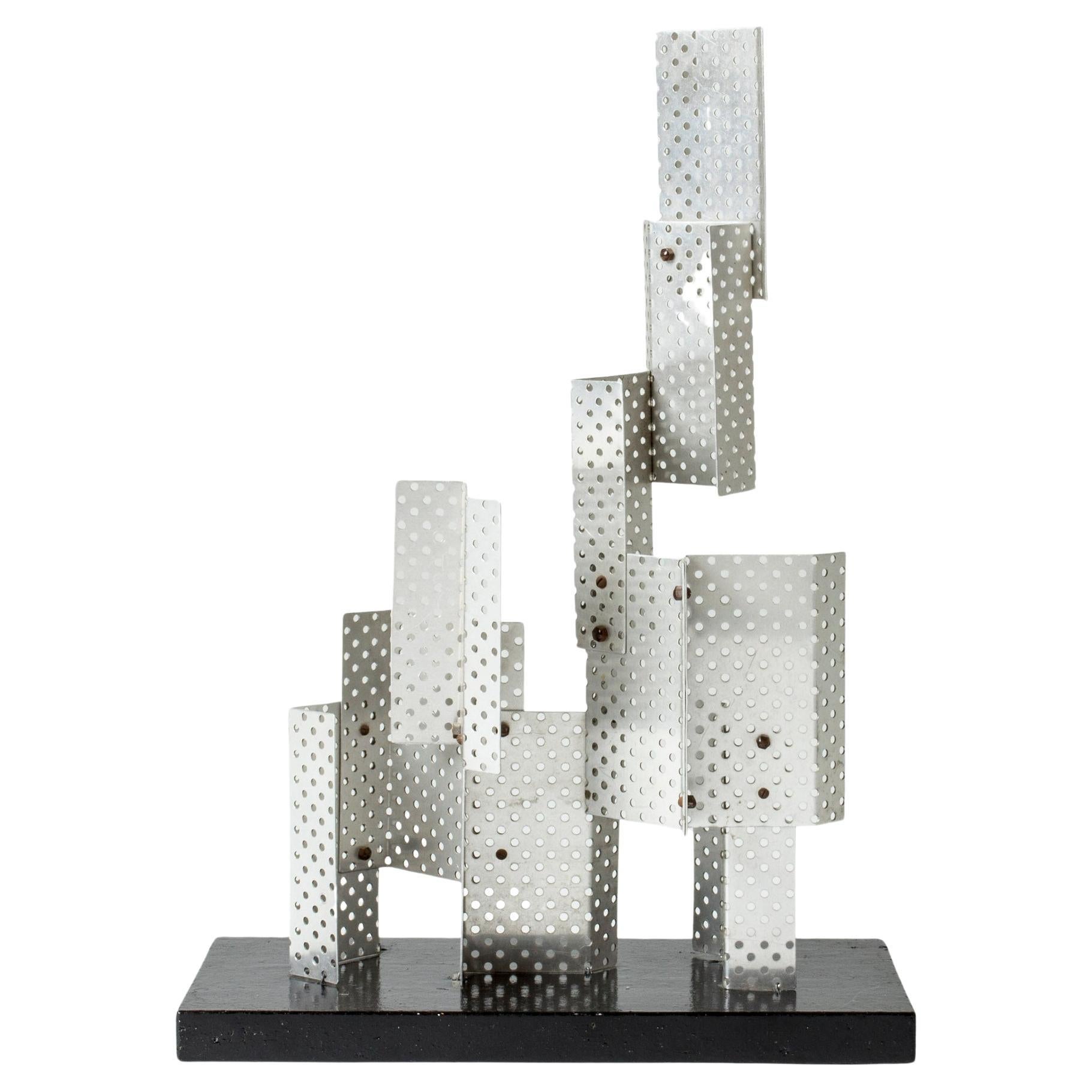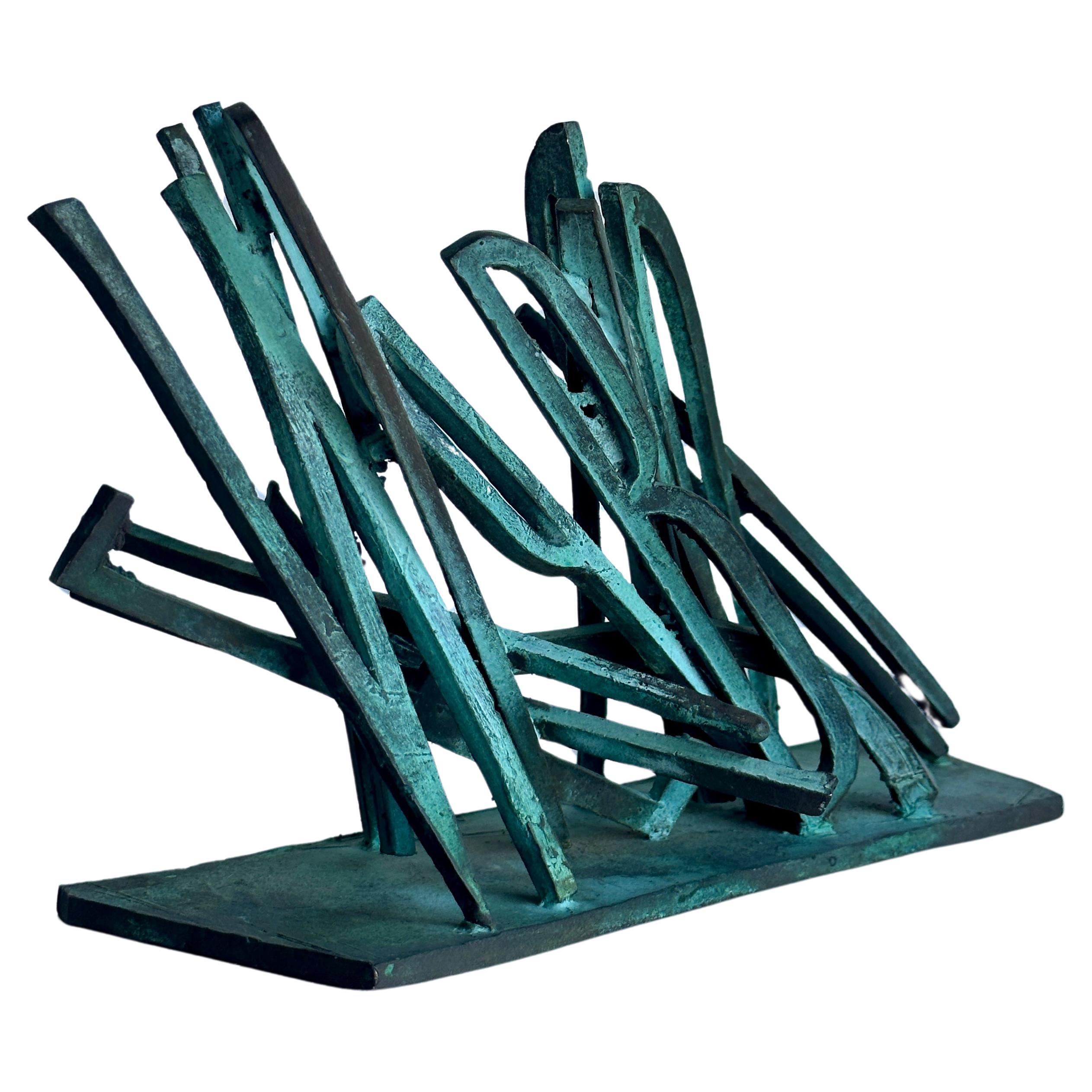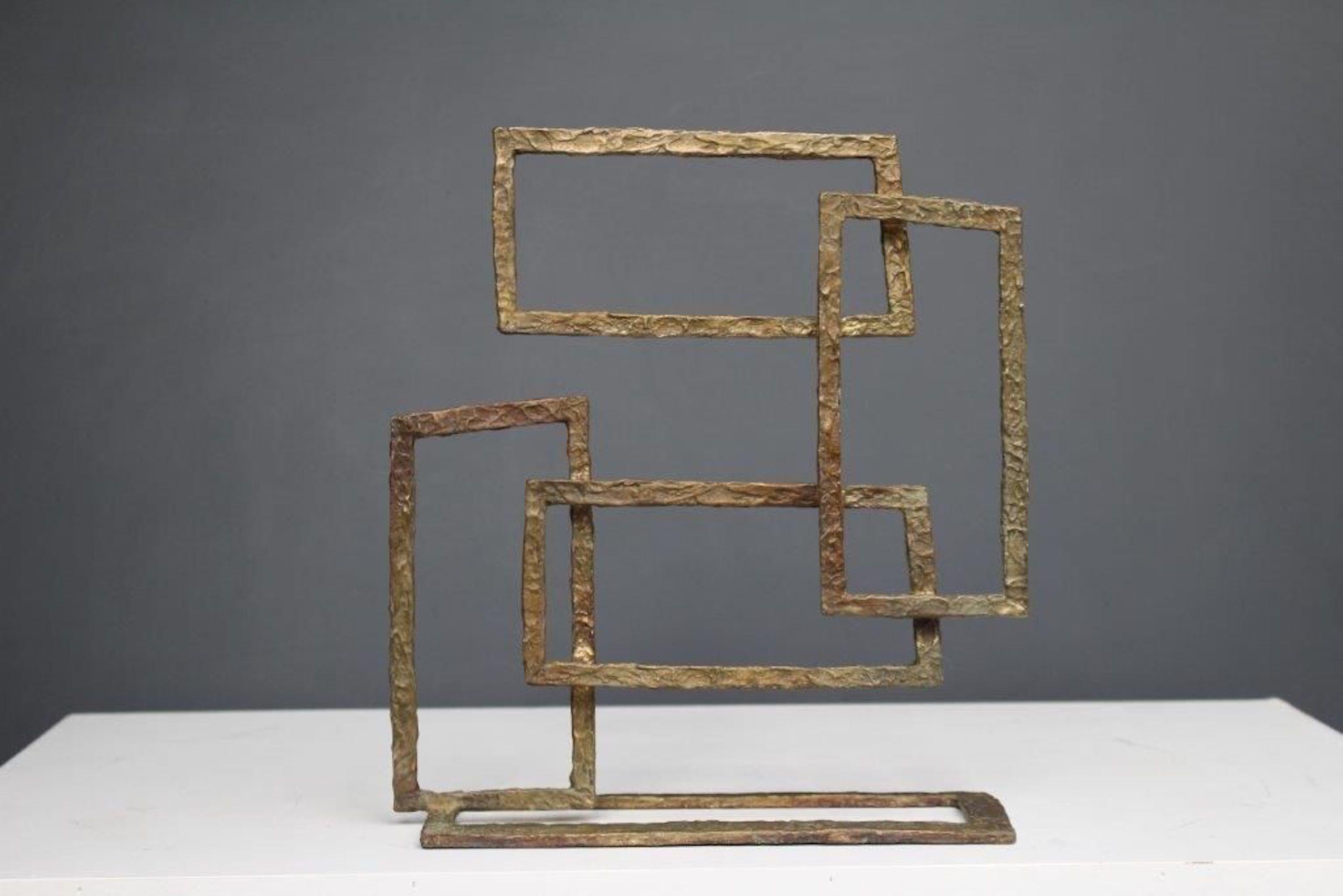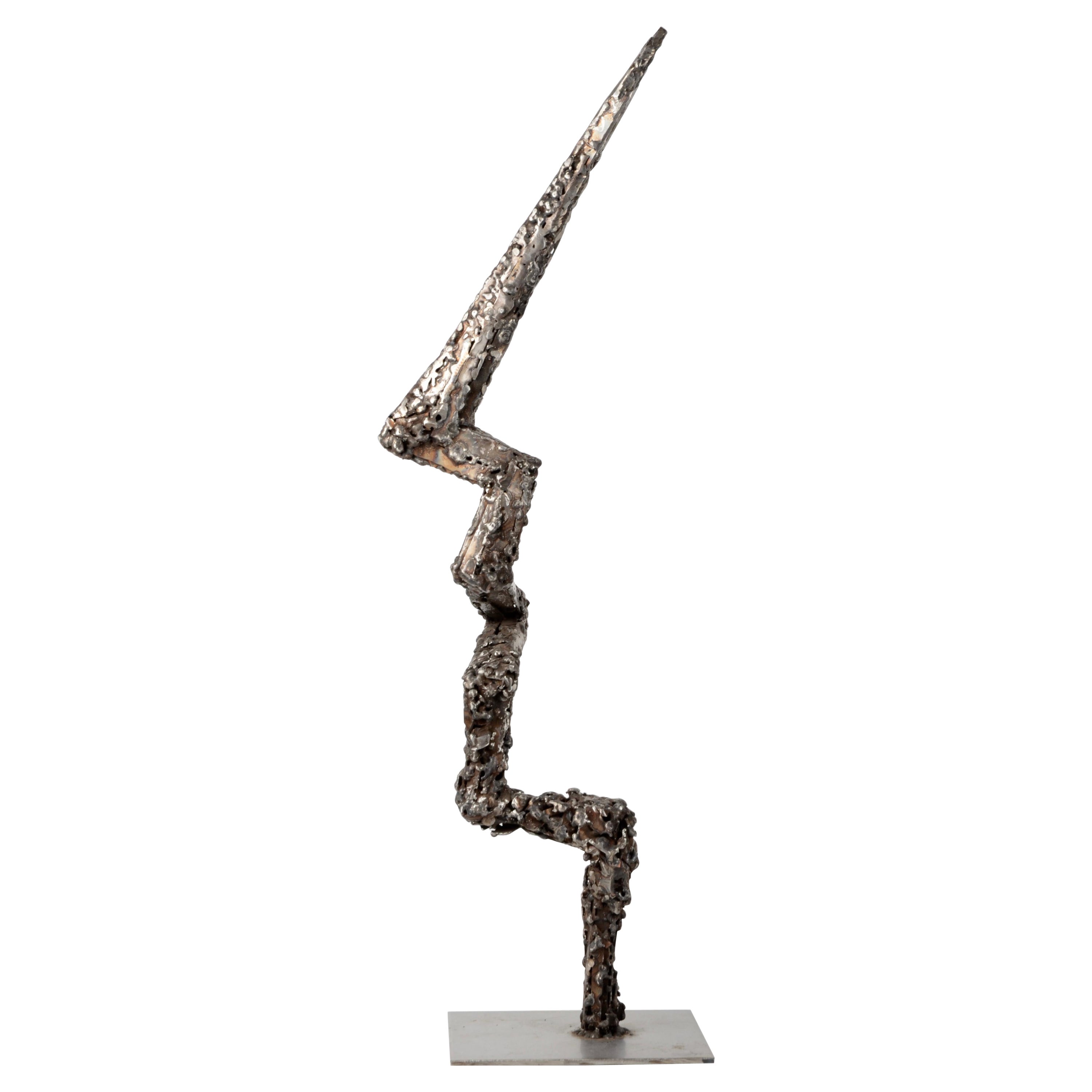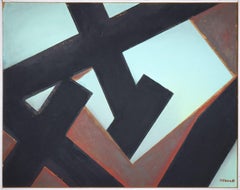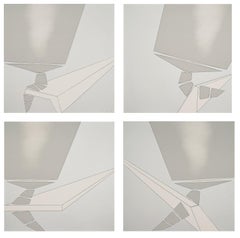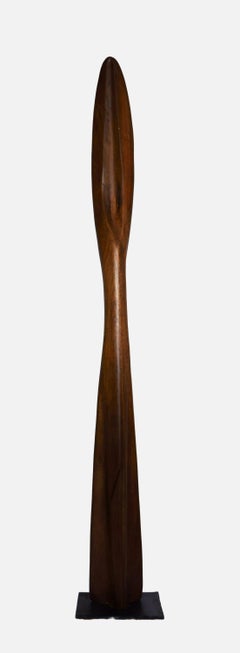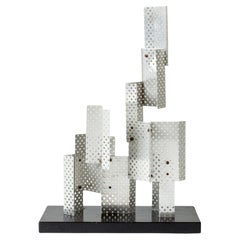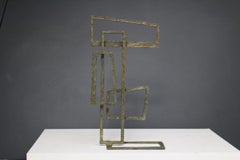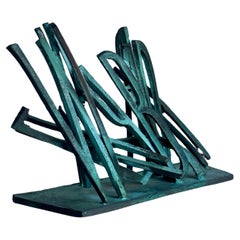Items Similar to Gradual Rotation / - Dynamic Tectonics -
Want more images or videos?
Request additional images or videos from the seller
1 of 9
Thomas RöthelGradual Rotation / - Dynamic Tectonics -c. 2005
c. 2005
$5,310.37
£4,035.54
€4,500
CA$7,461.34
A$8,181.13
CHF 4,276.87
MX$97,984.89
NOK 53,951.80
SEK 50,606.80
DKK 34,290.14
About the Item
Thomas Röthel (*1969 Ansbach), Gradual Rotation, around 2005. Steel with rust patina mounted on stone plate. Overall dimensions: 38 cm (height) x 34 cm (width) x 27 cm (depth), weight 12.3 kg.
- in excellent condition
- Dynamic Tectonics -
The two equally sized steel blocks appear to have once formed a single block. In combination with the horizontal stone slab, the vertical blocks exude an architectural calm that makes the dynamic action between the steel blocks, now divided into two equal bodies, seem all the more energetic. As if the inherent forces of the block had been released explosively, it is torn open in the middle to form a crescendo.
However, the release of the inner forces has not resulted in the original cuboid splitting into two separate vertical bodies; rather, the two parts are connected by the filigree lines of force and perform an intrinsically balanced balancing act. The dynamics, in turn, flow into an overarching calmness that is, however, supported by a virtuoso structure of tension. The dynamic is by no means at a standstill within the stillness, but is constantly in progress, as can be seen by walking around the sculpture. The processual character of the ongoing event is also illustrated by the film of rust, which - like the release of inner forces - is also a material process.
While Richard Serra creates spaces of tension with his steel sculptures, Thomas Röthel releases the material's internal potential for tension and reveals the dynamic order inherent in tectonics. If Serra's sculptures transcend the human scale and thus create a sublime effect, Röthel's steel plates, which float on space-bending lines of force, also unfold a sublime effect.
"Every line, every curve can be calculated in advance with mathematical precision according to the given conditions of the material. And yet there is only one moment of genesis that cannot be grasped by the mind, in which a simple block of steel becomes a work of art beyond mathematics and physics. In the hands of Thomas Röthel, the scientific laws inherent in this work of art become poetry in form.
- Erich Schneider
About the artist
After training as a wood sculptor from 1986 to 1989, Thomas Röthel studied at the Academy of Fine Arts in Nuremberg with Johannes P. Hölzinger. Since then he has worked as a freelance artist in Oberdachstetten.
Röthel mainly creates steel sculptures in his own workshop. Since 2015, he has also been using the production halls of SFG STEELforming GmbH in Burbach in the Siegerland, with whom the American sculptor Richard Serra also works.
Selected Bibliography
Thomas Röthel. Steel Sculptures 1997 - 2008, Edition Kittelberger, Reutlingen 2009.
GERMAN VERSION
Thomas Röthel (*1969 Ansbach), Graduelle Drehung, um 2005. Stahl mit Flugrostpatina auf Steinplatte montiert. Gesamtmaß: 38 cm (Höhe) x 34 cm (Breite) x 27 cm (Tiefe), Gewicht 12,3 kg.
- ausgezeichnet erhalten
- Dynamische Tektonik -
Die zwei gleich großen Stahlquader haben offensichtlich einmal einen einzigen Block gebildet. Im Verbund mit der horizontalen Steinplatte strahlen die vertikalen Quader eine architektonische Ruhe aus, die das dynamische Geschehen zwischen den nunmehr in zwei gleichgroße Körper zerteilen Stahlquader umso energetischer erscheinen lassen. Als ob dem Block innewohnende Kräfte explosionsartig freigesetzt worden wären, ist er ist mittig zu einem Formcrescendo aufgerissen.
Das Ausagieren der inneren Kräfte hat jedoch nicht dazu geführt, dass der ursprüngliche Quader in zwei voneinander getrennte Vertikalkörper separiert worden wäre, vielmehr sind beide Teile durch die filigranen Kraftlinien aneinandergebunden und vollführen einen in sich austarierten Balanceakt. Die Dynamik mündet wiederum in eine übergeordnete Ruhe ein, die allerdings durch ein virtuoses Spannungsgefüge getragen wird. Die Dynamik ist innerhalb der Ruhe keineswegs stillgestellt, sondern beständig im Gange, was sich im Umgehen der Skulptur offenbart. Das Prozessuale des andauernden Geschehens wird auch durch den Flugrost veranschaulicht, der – wie das Freisetzen der inneren Kräfte – ebenfalls ein Materialprozess ist.
Schafft Richard Serra mit seinen Stahlskulpturen Spannungsräume, so setzt Thomas Röthel das materialinterne Spanungspotenzial frei und offenbart das der Tektonik innewohnende dynamische Ordnungsgefüge. Übersteigen Sierras Skulpturen das menschliche Maß und erzeugen dadurch eine Erhabenheit, entfalten auch Röthels auf raumverkrümmenden Kraftlinien schwebende Stahlplatten eine Erhabenheitswirkung.
„Jede Linie, jede Krümmung ist gemäß den gegebenen Bedingungen des Materials mit mathematischer Genauigkeit vorher berechenbar. Und doch gibt es nur einen mit dem Verstand eben nicht fassbaren Moment der Genese, bei dem aus einem schlichten Stahlblock ein Kunstwerk jenseits von Mathematik und Physik wird. Unter den Händen von Thomas Röthel werden die diesem innewohnenden naturwissenschaftlichen Gesetzmäßigkeiten zur Gestalt gewordenen Poesie.“
- Erich Schneider
zum Künstler
Im Anschluss an eine Ausbildung zum Holzbildhauer von 1986 bis 1989 studierte Thomas Röthel an der Kunstakademie Nürnberg bei Johannes P. Hölzinger. Seitdem ist er in Oberdachstetten als freischaffender Künstler tätig.
Röthel kreiert vorwiegend Stahlskulpturen, die er in der eigenen Atelier-Werkstatt anfertigt. Seit 2015 nutzt er zudem die Produktionshallen der SFG STEELforming GmbH in Burbach im Siegerland, mit der auch der amerikanische Bildhauer Richard Serra zusammenarbeitet.
Auswahlbibliographie
Thomas Röthel. Stahlskulpturen 1997 - 2008. Edition Kittelberger, Reutlingen 2009.
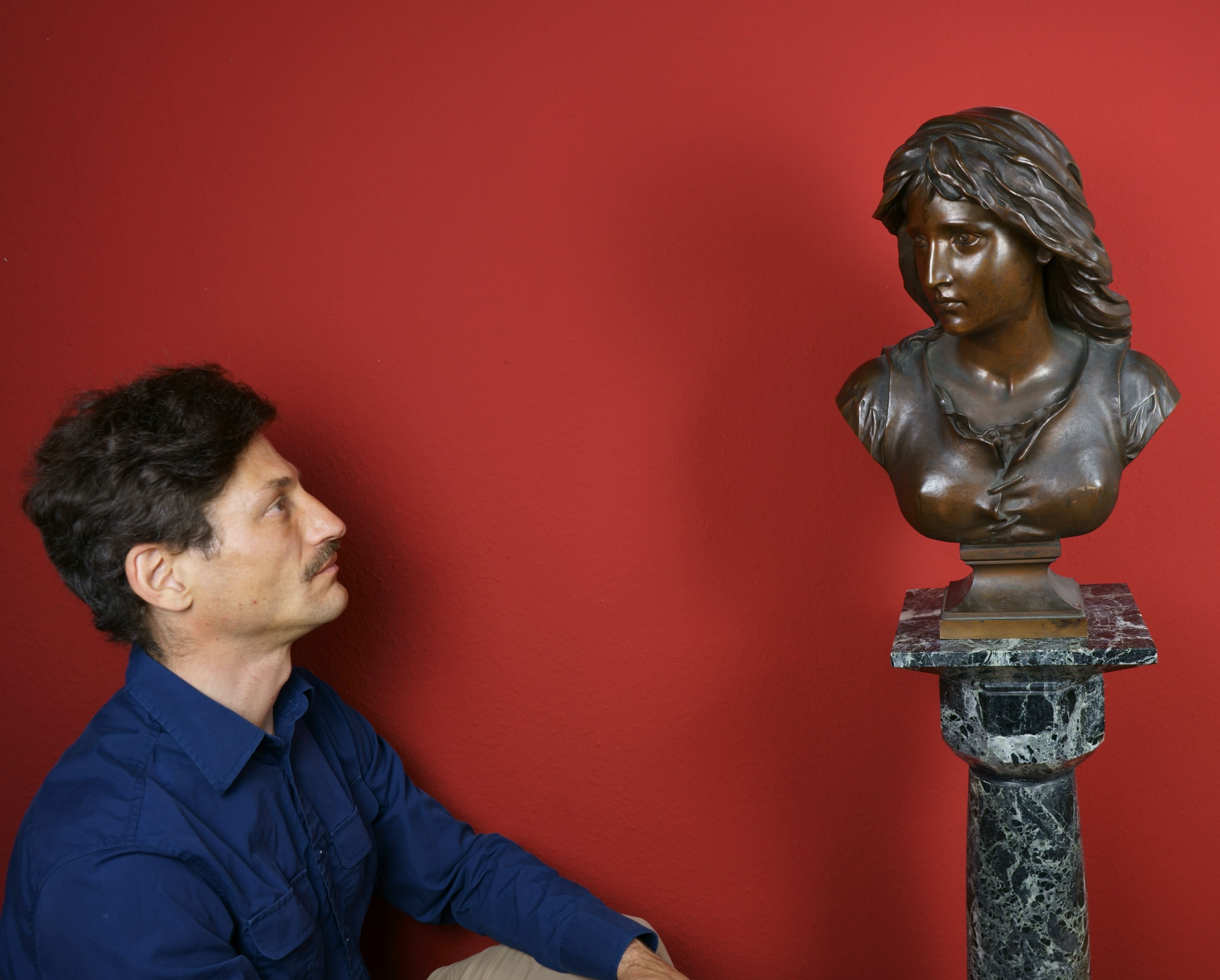
About the Seller
5.0
Vetted Professional Seller
Every seller passes strict standards for authenticity and reliability
Established in 2014
1stDibs seller since 2023
22 sales on 1stDibs
- ShippingRetrieving quote...Shipping from: Berlin, Germany
- Return Policy
Authenticity Guarantee
In the unlikely event there’s an issue with an item’s authenticity, contact us within 1 year for a full refund. DetailsMoney-Back Guarantee
If your item is not as described, is damaged in transit, or does not arrive, contact us within 7 days for a full refund. Details24-Hour Cancellation
You have a 24-hour grace period in which to reconsider your purchase, with no questions asked.Vetted Professional Sellers
Our world-class sellers must adhere to strict standards for service and quality, maintaining the integrity of our listings.Price-Match Guarantee
If you find that a seller listed the same item for a lower price elsewhere, we’ll match it.Trusted Global Delivery
Our best-in-class carrier network provides specialized shipping options worldwide, including custom delivery.More From This Seller
View AllTectonic Tension / - Archetypes of Painting -
Located in Berlin, DE
Jürgen Möbius (*1939 Großenhain), Tectonic Tension. Oil on hardboard, 47.5 x 60 cm, 49 x 61.5 cm (frame), signed lower right "Möbius" and dated "[19]81".
- Upper left corner with a small chip, light scratches and a little rubbed in places. Provisional gallery frame with traces of use.
- Archetypes of Painting -
About the artwork
The form structure in front of the eye is overlapped by the frame. Thus, the frame does not open up a space in which something is presented, but rather shows the seemingly arbitrary section of a comprehensive context that cannot be framed as such.
We see forms that stand in a structure of tension with each other, whereby the individual black and brown forms, which continue almost endlessly beyond the frame, already show a tension in themselves, since they are not only forms, but also surfaces - form surfaces, while the light blue surface ground is at the same time forms that appear as surface forms. The formed surfaces and surface forms are nested within each other and form a structure that encompasses all elements.
The angular arrangement of the black and brown shaped surfaces gives the structure a tectonic character. The tension is thus heightened to the point of paradox, since the black shape at the front is overlapped by the brown shape at the bottom in the center of the picture, which would be impossible in real space. It is precisely through this "paradox" that Möbius demonstrates that the paradoxical is reality within painting. It is, so to speak, the most original possibility of painting, which distinguishes it from the other arts. In combination with the tectonic formations, Jürgen Möbius creates an archaic primordial painting, which, however, should not be confused with the autonomous color and form cosmos of Suprematism à la Kasimir Malevich. Instead of homogeneous, perfectly colored forms, here the colors are deliberately applied unevenly, and the light blue is mixed with the brown in a manner determined by the brushstroke. At the edges of the surface forms, the uneven application of paint allows the wood of the unprimed hardboard to show through. In this way, Möbius illustrates that we are dealing with a painting that has been created by an act of painting - an act, however, that takes hold of the original principles of painting and thus realizes painting as such.
About the artist
From 1959 to 1965 Jürgen Möbius studied painting at the University Institute for Art and Work Education in Mainz. He also studied philosophy and art history at the University of Mainz. Afterwards he worked as a freelance artist in Mainz.
At first, Möbius created material reliefs and installations, then, around 1974, he turned increasingly to conceptual art and added cinematic means. During this phase he wrote the manifesto-like essay "Principles of Supranatural Landscape" (1979).
From 1981 on, Möbius concentrated on painting and searched for artistic ways to "treat intellectual and sensual perception equally in the fusion of representational and abstract pictorial elements" (Wolfgang Zemter). He found inspiration on his study trips to Thailand and Sri Lanka.
"The pure painting of Jürgen Möbius flows through us as a timeless expression of memory and energy, ploughing our perception and bringing us the happiness of seeing authentic, immovable form.
- Philippe Büttner
Selection of solo exhibitions
1969 Galerie Würzner, Düsseldorf / Galerie Gurlitt, Mainz
1972 Städtische Galerie, Mainz
1973 Galerie Schloss Ringenberg Rathaus, Kleve
1974 Röderhausmuseum, Wuppertal
1976 Galerie Glasing, Osnabrück / Städtische Galerie, Herne
1977, 1997, 2004 Märkisches Museum, Witten
1979 Studio M, Bamberg / Staatstheater, Darmstadt
1980 Galerie Stolànovà, Wiesbaden / Mittelrheinmuseum, Koblenz
1982 Galerie Dornhöfer, Mainz
1984 Galerie Neumühle, Schlangenbad
1985 Landesmuseum, Mainz / Kunstverein, Ludwigshafen / Nassauischer Kunstverein, Wiesbaden
1986 Museum, Bochum / Galerie der Stadt Iserlohn
1987, 1990 Galerie Klaus Kiefer, Essen
1987, 2000 Galerie Ulrike Buschlinger, Wiesbaden
1988 Kunsthalle Darmstadt
1988, 1992, 1996, 1999 Galerie Leonhard, Basel
1992, 2002 Galerie Zulauf, Freisheim
1994 Galerie Remy, Vallendar
1995 Sendezentrum des Zweiten Deutschen Fernsehens, Mainz
2001 Collegium oecumenicum, Bamberg / MVB Forum für Kultur und Wirtschaft, Mainz
2006 Adam Gallery, London
Selection of group exhibitions
1969 ‘International Graphic Arts’, Galerie Dalléas Bordeaux, Paris
1975 ‘Deutscher Künstler-Bund’, Dortmund
1979 ‘Man and man’s Images’, Märkisches Museum Witten
1980 ‘Love-Dokuments of our Time’, Art Hall Darmstadt and Art Association Hannover
1982 ‘Work - Progress – Position’, Nassau Art Association Wiesbaden
1983 ‘Principle Hope – Utopic Aspects in Art and Culture of the 20th Century’, Museum Bochum
1986 ‘Selfportraits’, Gallery Klaus Kiefer Essen
1987 ‘The Dying and Death’, Gallery Klaus Kiefer Essen
1989 ‘Where are You, Revolution – Freedom, Liberty, Egality, Fraternity to-day’, Museum Bochum 1990 ‘Flight – a Problem within the Memory of Man’, Kunsthalle Darmstadt ‘Art and War 1939 – 89’, House of Cultures Berlin
1991 ‘Material and Form’, Pillnitz Castle Dresden and Pfalz Gallery Kaiserslautern
1995 20 Years Exhibitions, Chrämerhuus Langenthal, Schweiz
1998 ‘Works on Paper’, Klaus Kiefer Gallery Essen
2000 ‘Acquisitions 1900 – 2000’, Mittelrhein-Museum Koblenz
2001 ‘Strange Pictures’, Klaus Kiefer Gallery Essen
2002 ‘10 Years Buschlinger Gallery’, Buschlinger Gallery Wiesbaden
2004 ‘Eternal Space – Pictures and Sculptures’, Dome of Bamberg
2005 Art Fair Chicago, Adam Gallery, London
Selected Bibliography
Mittelrheinisches Landesmuseum (Hrsg.): Jürgen Möbius - Neue Bilder, Mainz 1985.
Kunstverein Darmstadt (Hrsg.): Jürgen Möbius. Bilder 1985 - 1988. Kunsthalle Darmstadt, 26. Juni - 14. August 1988. Red. Dorit Marhenke, Lyrik Marcus Schiltenwolf, Düsseldorf 1988.
Gabriele Prusko (Hrsg.): Jürgen Möbius. Mit Texten von Philippe Büttner und Ralph Mieritz, Basel 1992.
Wolfgang Zemter (Hrsg.): Jürgen Möbius - Aktuelle Arbeiten. Märkisches Museum der Stadt Witten, Bönen 1999.
Wolfgang Zemter (Hrsg.): Jürgen Möbius. Flieger in meinem Zimmer und Beruhigte Zone, Bönen 2004.
Dama Gallery...
Category
1980s Abstract Abstract Paintings
Materials
Oil
$1,321 Sale Price
20% Off
Untitled / - Dancing Sculpture -
By Gerlinde Beck
Located in Berlin, DE
Gerlinde Beck (1930 Stuttgart-Cannstatt - 2006 Mühlacker-Großglattbach), Untitled, 1973. Series of four serigraphs, 29.8 cm x 29.8 cm, each signed in lead on the front and numbered on the reverse. Sheet 1-3 no. 74/100, sheet 4 no. 48/100.
- Corners occasionally slightly bumped, minimal crease, otherwise in very good condition
- Dancing Sculpture...
Category
1970s Abstract Geometric Abstract Prints
Materials
Paper
Vegetative Form / - Grown Art -
Located in Berlin, DE
Paul Dierkes (1907 Cloppenburg - 1968 Berlin), Vegetative Form. Mahogany, 1958. 142 x 16 x 10 cm (sculpture), 21 x 17.5 cm (base), monogrammed "PD" on the reverse.
- Grown Art -
...
Category
1950s Post-War Abstract Sculptures
Materials
Mahogany
$3,304 Sale Price
20% Off
Untitled / - The archaism of nature -
Located in Berlin, DE
Jorge Machold (1940 Chemnitz - 2015 Berlin), Untitled, 1973. Color etching, 41.5 x 29.2 cm (plate size), 49.5 cm x 39.5 cm (sheet size), signed lower right in lead “J.[orge] Machold”...
Category
1970s Abstract Abstract Prints
Materials
Paper
Collage with metal application / - Rhythm and Reflection -
Located in Berlin, DE
Hermann Goepfert (1926 Bad Nauheim - 1982 Antwerp), Collage with metal application, 1965. Contribution no. 14 from the anthology 'La lune en rodage II' published by Editions Panderma...
Category
1990s Abstract Mixed Media
Materials
Paper
My treasure, my sanctuary / - A Tortured Treasure -
Located in Berlin, DE
Johannes Heisig (*1953 Leipzig), "My treasure, my sanctuary" - To the Christmas Oratorio by Johann Sebastian Bach. Lithograph on strong yellowish laid paper with watermark, 53 x 39.5...
Category
1980s Abstract Expressionist Figurative Prints
Materials
Lithograph
$358 Sale Price
20% Off
You May Also Like
Sculpture by Lars Erik Falk, Sweden, 1968
By Lars Erik Falk
Located in Stockholm, SE
Striking sculpture by Lars Erik Falk, made from aluminium perforated with holes. The different angles create a beautiful play with light.
Category
Vintage 1960s Scandinavian Modern Abstract Sculptures
Materials
Aluminum
Equilibrio Arquitectonico III, 2009
Located in Atlanta, GA
The painter and sculptor Martín Carral studied Fine Arts at the University of Barcelona. Carral has been painting gravitational waves for many years, an ...
Category
21st Century and Contemporary Modern Abstract Sculptures
Materials
Mixed Media
Composition IV by Delphine Brabant - Abstract geometric bronze sculpture
By Delphine Brabant
Located in Paris, FR
Composition IV is a bronze sculpture by contemporary artist Delphine Brabant, dimensions are 48 × 24 × 12 cm (18.9 × 9.4 × 4.7 in).
The sculpture is signed and numbered, it is part ...
Category
2010s Contemporary Abstract Sculptures
Materials
Bronze
Bronze Alphabet Sculpture by Sharbek Almajkov
Located in Greensboro, NC
This bronze “leaning alphabet” sculpture is signed by the artist, who was known by his given name but also went by an assumed name; he called himself Sharbek Almajkov. We acquired th...
Category
Late 20th Century American Modern Abstract Sculptures
Materials
Bronze
Composition V by Delphine Brabant - Abstract geometric bronze sculpture
By Delphine Brabant
Located in Paris, FR
Composition V is a bronze sculpture by contemporary artist Delphine Brabant, dimensions are 33 × 30 × 11 cm (13 × 11.8 × 4.3 in).
The sculpture is signed and numbered, it is part of...
Category
2010s Contemporary Abstract Sculptures
Materials
Bronze
Torsten Treutiger (1932-2019), sculpture "PROFIL II"
Located in Stockholm, SE
Sculpture in steel, "PROFIL II", by Swedish artist Torsten Treutiger. Signed and marked with artist information as well as the price set by the artis...
Category
Early 2000s Swedish Post-Modern Abstract Sculptures
Materials
Stainless Steel
